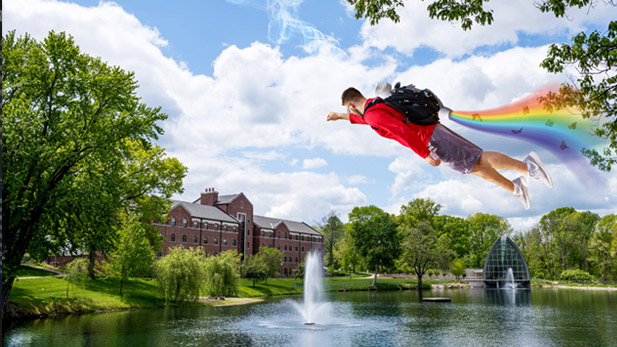Multidisciplinary Collaboration Leads to Revolutionary Campus Transportation Solution

Next August, students will be able to literally fly across campus, thanks to a collaboration between the institute’s departments of chemistry, physics and mechanical engineering.
New additions to Rose-Hulman Institute of Technolgy’s state-of-the-art academic facilities have spurred an innovative solution to increase cross-campus transit times—and resulted in a groundbreaking discovery in propulsion technology.
Each fall, incoming freshmen are provided with sturdy backpacks in which to carry their Rose-specific laptops and textbooks. But next year’s class will be the first to be issued backpacks with a built-in means of transportation, turning a typically mundane student accessory into a futuristic personal aerial transportation device.
That’s right. Next August, students will be able to literally fly across campus, thanks to a collaboration between the institute’s departments of chemistry, physics and mechanical engineering.
The project was the vision of institute president Robert A. Coons, who in October boldly declared that, “We choose to develop flying backpacks by the end of 2018, not because they are easy to create, but because they are hard.”
The project, and its aggressive timeline, presented unique challenges, not the least of which was the propulsion method itself.
“Traditional rocket technology generates too much heat to use in an application such as this,” explains Dr. Emmett Brown, director of meretricious initiatives for the college. “The proximity of the backpack to the student’s body meant that we needed a solution that was functional, but also safe.”
Dubbed the RC3000, in honor of Rose-Hulman’s Coons, the backpack’s propulsion system uses a revolutionary reverse combustion technology, which relies on vacuum rather than pressure. The device emits neither the heat nor the exhaust associated with traditional combustion.
“It actually removes atmospheric carbon dioxide and reduces ozone depleting pollutants, leaving cleaner air in its wake,” says Provost and Vice President of Academic Affairs Anne Houtman. “That the resulting vapor trail looks like a rainbow is just the icing on the cake.”
An added benefit is that the reverse combustion generates excess energy that students can use to wirelessly charge their laptops and phones—on the fly.
The institute’s administration hopes that the new transportation option will provide an alternative for commuter students that will help mitigate some parking shortages caused by ongoing construction projects.
According to Jake Campbell, Rose-Hulman’s Senior Director of Safety and Security, students will still be expected to observe all stop signs, speed tables and campus traffic rules.
“The institute has a rich history in space exploration, from our alumni who had significant roles in the Apollo missions and helped put the first man on the moon, to our “Study in Space” partnership with NASA. This breakthrough in propulsion technology is indicative of our continuing quest to be on the leading edge of innovations in science and engineering,” Brown says.